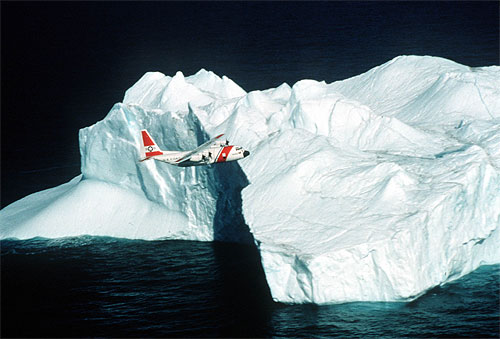 October 25, 2007 (SitNews) - The U.S. Coast Guard announced a C-130 departed Barrow, Alaska today to fly 1,183 miles to the North Pole as part of an increase in Arctic orientation flights. The crew, which will include a representative from the National Oceanic and Atmospheric Administration and the Barrow community, will assess changes in maritime activity in the region as recently observed climate changes provide greater access to the Arctic. "The northern reaches of the Arctic is a new area for us to do surveillance," said Rear Adm. Arthur E. Brooks, commander of the Seventeenth Coast Guard district based in Juneau, Alaska, which is at the forefront of the service's Arctic operations. "We are expanding our patrols because we are seeing increased activity in the region and we need to know what is going on up there."  U.S. Coast Guard photo
The Arctic region is the focus of increasing interest as a shipping route between the Atlantic and Pacific Oceans, offering a potential route between Europe and Asia that is 4,000 miles shorter than a transit through the Panama Canal. Among the needs the Coast Guard has identified is the potential for a traffic routing system to define shipping lanes in rapidly changing waterways. "The Arctic is emerging as a functioning body of water with implications for commerce, tourism and transport," said Adm. Thad Allen, commandant of the Coast Guard. "The great distances and harshness of the Arctic climate means we have to be prepared for a new defined mission set in an enormously challenging environment. Our nation needs further analysis of trends in Arctic activity and the associated risks to the region, clear national policies and priorities that address the new challenges in the Arctic, and continuing research to provide better understanding of the Arctic." Allen has encouraged ratification of the Convention on the Law of the Sea, which provides an international framework for defining the rights and responsibilities of nations in their use of the world's oceans and marine natural resources. In a speech Sept. 27 before the Institute for Foreign Policy Analysis, Allen discussed emerging access to the Arctic region and the need to work cooperatively to address challenges and opportunities arising from changes in the region. The speech can be found online at http://www.uscg.mil/comdt/. "As polar ice coverage recedes, previously impassable channels are becoming open waterways for at least part of the year," said Capt. Jim McPherson, chief of public affairs. "These newly open waterways in some of the harshest maritime operating environments on earth are, in many cases, uncharted and present safety of navigation issues that must be resolved." "The growth in all Coast Guard missions above the Arctic Circle has already begun," said Brooks. "We are already seeing more mineral, oil, and gas exploration, more vessel traffic, and more scientific missions. We expect this trend to increase dramatically as the United States and other nations focus on the Arctic as an accessible waterway and a rich source of natural resources." "The Arctic is a pristine and environmentally sensitive region that must be protected. We as a nation must understand the challenges and opportunities these changes in the environment might present," said Brooks. "The Coast Guard is well-suited to address new challenges and opportunities in this predominantly maritime domain." The Coast Guard brings over a century of experience in the Arctic region. The service is marking the 50th anniversary of three cutters breaking through ice to cross the Bering Strait and into the Arctic Ocean to determine the feasibility of the Northwest Passage as a route for cargo vessels to re-supply the early warning radar network - a critical front for national defense at the height of the Cold War. The cutters' three-month voyage across the northern edge of the North American continent helped resolve much of the uncertainty about the 4,500 miles of semi-charted waters through which they sailed. The Coast Guard cutter Healy,
an icebreaker based in Seattle, completed a mission in September
with the National Oceanic and Atmospheric Administration to map
the sea floor in the Arctic region. The cutter will return to
the region in the spring. Source of News & Photographs:
Publish A Letter in SitNews Read Letters/Opinions
|